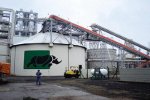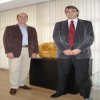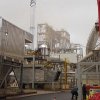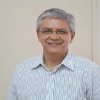A major Alliance
3 December 2009Duratex has expanded, not just in terms of its recently-announced merger with Satipel Industrial, but with the launch in June of a huge, 77m-long, continuous MDF press line – the world’s longest to date – at its Agudos plant.
Duratex originally planned to install the 750,000m3/year eucalypt-based Siempelkamp line back in 2007, when markets in Brazil and abroad were booming. In the past five years, domestic sales of MDF have risen at up to 15% per year thanks to strong furniture industry growth.
Then, just as Duratex and other Brazilian MDF producers proudly made ready to launch their new lines, the global economic crisis hit, slamming the boom into reverse and leaving panel manufacturers saddled with substantial overcapacity. Duratex was forced to rethink its short-term plans.
Originally, the new MDF line was part of the company’s strategy to dedicate production of thin and standard thickness fibreboard products to different lines. Duratex also operates a 250,000m3/year pine based MDF production line at Agudos and a 450,000m3/year MDF/HDF unit at its Botucatu mill.
“The strategy was to have this big [new] line to produce basically 6x9ft products from 12-18mm [standard MDF], and to concentrate the Botucatu MDF line and Agudos Line I on special [thin] products,explained Carlos Gama, Duratex’s engineering, development and environment manager.
Speaking soon after Agudos MDF II start-up in late June, he told WBPI on a visit to the plant that the plan was to run the big line eight hours a day through to the end of August before the product’s planned market launch at that time.
“Then, depending on the state of the market, we will be ready to increase the output,the executive explained.
The super-press line comprises wood-yard and refining equipment provided by Andritz; Siempelkamp machinery from the dryer up to the end of the line, with the sanding section from Steinemann. The biomass energy plant was supplied by the Belgian company Vyncke NV.
Duratex was hopeful that Brazilian domestic demand for MDF, which fell in the first half of 2009, would benefit from lower interest rates and a government stimulation package in the final six months of this year. The home market is normally more buoyant in the second half of the year anyway.
However, the global recession has left its mark on even the strongest of Brazil’s panel manufacturers.
São Paulo-based Duratex is well aware that the sector’s recovery will not be short or sweet, and it will take the company several years before its sizeable panel production capacity is fully sold.
For Duratex, 2009 has already been a momentous year. The start-up of MDF II coincided with news that the company is spearheading a long-awaited industry consolidation through its merger with Brazilian MDP (medium density particleboard) major Satipel Industrial SA (WBPI Aug/Sept 09, p5). The new group, to be named Duratex SA, will have an overall capacity of around four million m3/year and rank as the biggest wood panel manufacturer in the Southern Hemisphere.
At the end of August, shareholders of both companies gave this deal the green light and the new US$1.6bn ‘super group’ was formed. In the meantime, directors and senior managers from the two companies have been discussing in detail the integration programme.
Asked about the new group’s likely future direction, Alexandre Coelho, Duratex commercial director told WBPI: “Right now we are consolidating our recent investments – Satipel and Duratex and we are focusing on integration”.
It is Mr Coelho who, as the ‘new’ Duratex’s wood business commercial director, will take on the challenge of marketing the group’s enlarged product portfolio in Brazil and abroad. He will also take on a wider industry role next year as president-elect of the country’s wood panel association ABIPA.
The new group has already given a clue as to how it means to recover business lost following the global economic setback. It is targeting foreign markets around the world in a concerted bid to expand exports which stood mid-year at a combined total of just 5% of sales.
“Our goal is to become the lowest cost producer in the world..,the group’s chairman Salo Seibel and its ceo Henri Penchas revealed in a joint statement at the time of the deal announcement.
The first major move in years to consolidate the industry was warmly welcomed in Brazil as a near perfect marriage between Satipel and Duratex. Their respective operations complement each other in terms of plants, products, customers, geographic spread and continuous line technology, while each brings around two million m3/year of panel capacity to the partnership.
The advent of MDF II at Agudos represents a US$150m chunk of a substantial US$350m Duratex investment programme, which also covers the construction of a US$50m formaldehyde and resin plant at the site and the purchase of new forest land nearby.
The company expects to make a significant cost saving by adding the Perstorp resin plant which will also supply raw materials to the Botucatu site 60km away. The plant equipment arrived on site in July and the unit is set to start up this December (09) and will deliver chemicals fully from early 2010, forecast Mr Gama.
The forestry investment involved the acquisition of the Lençois Paulista area close to the Agudos plant, comprising 18,000ha of forest land to provide additional planted eucalypt wood to feed the new MDF II line.
For years, Duratex has maintained and expanded its tree plantation resource around its panel plants in São Paulo state. Today, it owns more than 123,000ha of forest located on average 55km from the plants, ensuring it has the lowest wood cost in the industry.
Duratex is in the process of switching its forest base from pine to rapid growing eucalypt trees. New plantations are now of eucalyptus, though the firm has sufficient pine wood to fuel the MDF I line at Agudos for up to seven years, explained Mr Gama.
In the past year, Agudos has seen further spending on panel finishing facilities. A second low pressure melamine line with a 180,000m3/year capacity was supplied by Siempelkamp in July 2008, and a third line with the same output was being purchased for the site this year.
This investment, along with the installation of a small mouldings line, able to turn out five million moulded skirting board strips per year for Duratex’s laminated flooring products range, demonstrate the importance the firm now attaches to value-added products.
“We are not only a commodity [products] company, but an added-value company too. We started to develop a new market and business in civil construction last year,pointed out Mr Coelho. His company also planned to launch a door components business this year, he added.
A little over a year ago, Duratex revealed it was planning another revolutionary panel project when it announced its intention to build the world’s first one million m3/year particleboard plant. With its heavy focus on expanding fibreboard capacity and developing special thin MDF boards, the company was felt to be abandoning MDP. So Duratex’s answer to the market was the massive panel line scheme for its Itapetininga site.
The firm already operated a 500,000m3/year particleboard line, using 100% eucalypt fibre, which it had introduced back in 2000.
But late last year, Brazil was overtaken by the global recession and Duratex quickly announced it would postpone the huge Itapetininga line because of the international downturn. That decision proved wise in the light of the unforeseen merger deal with Satipel, whose wellinvested MDP operations to the north and south of São Paulo provided the balance its partner sought.
Duratex remains one of two major global suppliers of wet process hardboard, along with its fellow eucalyptbased panel maker, Eucatex SA.
However, last year, Duratex finally closed down its second hardboard production site in Jundiai, near São Paulo city. Duratex blamed a combination of the age of its three Jundiai 1950s lines and urban creep preventing expansion on the 150,000m3/year site for the shutdown. But export-reliant hardboard also suffered in 2008 from adverse exchange rates and the world recession.
The company still runs three newer wet process board lines, dating back to the 1970s and 1980s, with a 300,000m3/year output – two thirds of its former total capacity – at Botucatu. It was forced to switch the bulk of its business to the Brazilian market, according to Duratex’s commercial operations manager Giovanni Grossi.
Meanwhile, Duratex was developing special thin MDF products, including dry process super density fibreboard (SDF) and HDF panels which have begun to substitute for hardboard in certain market applications. The company has found that it is beginning to compete against itself with both hardboard and HDF in the marketplace, the commercial executive admitted.
Hardboard at home and abroad is still hugely profitable for its Brazilian producers and appears to have a future despite attempts to find an ideal replacement. “Hardboard is still recognised as a special product for certain applications. We intend to continue with the hardboard process at Botucatu, no doubt,confirmed Mr Gama.
The MDF line in Botucatu was originally installed to develop the thin HDF and SDF products. Although SDF, devised as a resin-free substitute for hardboard, entered the market two years ago, 80% of the line’s output in mid-2009 was still standard MDF. HDF and SDF had a 10% share each, according to Duratex.
Managers are convinced that greater economies of scale, attained partly through its merger with Satipel, will allow it to produce bigger thin board volumes and prove that SDF is the most cost-competitive product, said Mr Grossi.
“We have to get volume, scale and competitiveness in the cost of production in HDF lines,he declared. Once SDF is fully developed and can prove its value in the market, then the days of wet process hardboard could be numbered.
“SDF, at the right time, will certainly be the right [thin board] product to switch to in traditional hardboard markets, asserted Mr Grossi.
But for now, the well-tried characteristics and value of hardboard as a painted product are still very much in demand in the doorskin and civil construction markets, in Europe and the US particularly.
For Duratex, even the dark clouds of global recession have a silver lining, since it is clear the economic crisis spurred Brazil’s fragmented industry into the radical, but long overdue, consolidation process. Once the integration process with Satipel is complete a model group will emerge, leaner and fitter to take on the challenge of sector development.



